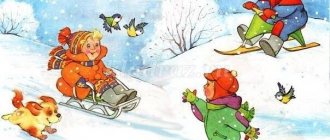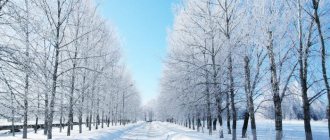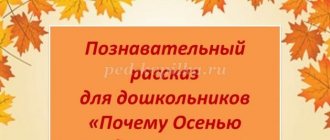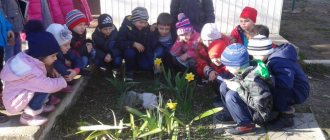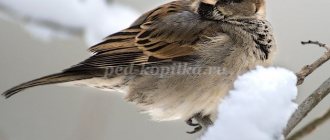Types of observations while walking
Kokhanova Natalya Sergeevna
Types of observations while walking
1. Observations of seasonal phenomena. Teach children to observe natural phenomena and establish connections between them. Introduce children to the characteristic features of the season. (changes in the lives of animals, birds, changes in soil, trees, plants, position of the sun). Teach children to observe seasonal phenomena in nature. Teach children to observe natural phenomena , analyze, establish causal relationships and dependencies. Teach children to draw conclusions about certain patterns and relationships.
2. Observations of weather conditions. Check out the weather with your children. Teach children to identify and name the state of the weather. Offer to answer the questions: what is the weather today, cold or warm, sunny or cloudy, windy day or calm. Find out why the children decided that the weather was like this today.
Teach children to determine the state of the weather by characteristic signs: the breeze is blowing, the trees are swaying, which means windy weather; the sun is shining, there are shadows on the ground - that means the weather is sunny, there is frost on the trees, the snow is not sticky - the weather is frosty. Strengthen children's ideas about seasonal changes in nature.
3. Observations of the animal world . Organize with children to observe birds , their behavior, appearance, coloring, plumage. Cultivate a desire to care for them, protect them, and feed them. Organize observations of animals , appearance features, habits. Clarify children's knowledge about the way of life of animals (domestic and wild, habits, care for them. Organize with children the observation of insects ( their habitat, features of appearance)
Teach children to recognize animals, birds, insects by color, sounds, method of movement, behavior. Give children an idea of the life of animals, birds, insects at different times of the year.
4. Observation of the flora (in the forest, field, meadow, garden, kindergarten area)
Organize with children
to observe plants (trees, shrubs, herbs)
. Teach children to compare them, find common and distinctive features. Give children an idea about growing plants and caring for them.
Teach children to behave correctly in nature, talk with them about caring for plants, about protecting nature, about correct behavior in nature (do not break bushes, do not pick flowers)
.
Give children an idea of plants at different times of the year. Teach children to distinguish plants, trees, and shrubs by their bark, leaves, flowers, and fruits. Organize long-term observations (of flowers in a flowerbed, of a vegetable garden, noting changes over the past period.
5. Observations of inanimate nature . Organize with children observations of soil , water, sand, stones, ice, snow. Organize experimental activities with sand and snow , ice (freezing colored water, bringing snow to the group, sculpting from dry and wet sand, examining the soil under a magnifying glass, etc.) Learn to establish cause-and-effect relationships in the state of inanimate nature depending on the season.
6. Observing the work of adults . Continue to introduce children to the work of a janitor, driver, and builder. Expand children's understanding of tools, labor actions, the names of clothes, various machines, and emphasize the importance of workers' labor for society.
7. Observations of street life . Targeted walks . Help children list types of public transport. Older children will learn the purpose of a truck, van, ambulance and fire truck. Observation of the various work of snow removal machines. Introduce children to traffic lights and their signals. A targeted walk can be for younger preschoolers to the area of older children. There may be a walk - an excursion to the square where the New Year tree is installed.
Planning walks in the middle group according to the Federal State Educational Standard
Let's look at the file of observation walks for the middle group of preschool educational institutions. In order for the walks to be interesting and at the right pace, it is necessary to draw up a plan and preliminary preparation on various topics.
Walk 1 – Autumn Tree Watching
Goal: learn to find distinctive features of trees in autumn compared to summer. To see extraordinary beauty in the autumn colors of trees.
Progress of observations: read the poem by A. S. Pushkin “Dull Time”.
Observe different trees with children. Find differences and similarities in the color of autumn leaves of oak, maple, birch, and rowan. Draw children's attention to the special beauty of the entire landscape in autumn, September, October, November.
Experience, experiment: collect beautiful autumn leaves for crafts on an autumn theme.
Outdoor game: competition with autumn fruits. Divide the children into two teams. Give each person one acorn (to the first team) and one chestnut (to the other team). From the beginning of the game, children from each team simultaneously run a race with their acorn (chestnut) to the marked place and throw it into the bucket. Those who run faster win. Physical exercise and reaction to speed will charge children with vigor and fun.
Walk 2 - Watching Snow During the Winter Months
Goal: learn to observe changes in nature in winter.
Progress of observations: note if snowfall means warming. Snowflakes crunch underfoot - frost. In winter it gets dark early - especially in December. In winter comes New Year and Christmas. Children sled, skate, ski, and play snowballs.
Experience, experiment: carrying out an analysis - measure the depth of a snowdrift in the sun and in the shade, offer independent activity to the baby.
Outdoor game: snowball fight. An active, cheerful game will warm children, give them a good mood, and teach them accuracy.
Walk 3 - watching a cat in the spring area of the garden
Goal: remember the characteristic signs of a cat, its habits, behavior.
Progress of observations: read a poem about a cat, ask a riddle and ask which of the children knows poems about cats. Invite children to examine and describe the cat and its distinctive features. Talk about how spring affects cats (they become goulens). That with the arrival of spring, the cat's fur sheds lighter for the summer period. Build a dialogue with children in the form of a conversation.
Experience, experiment: try to play with a cat using a ribbon on a string. Warn children that they should not pick up unknown animals on the street.
Outdoor game: conducting physical education. Jumping on two legs while moving forward. Moving exercises have a beneficial effect on muscles.
Walk 4 - observing flowers and insects in the flower beds in summer
Goal: find out how summer differs from other seasons. A thematic walk near flowering flower beds, carrying out a walk according to the planned outline.
Progress of observations: what flowers bloomed in the flowerbed, ask who knows what they are called, how the flowers differ from each other. Observing bees - how they pollinate flowers. Tell them how important their work is in nature. Ask children what insects they know, identify their differences and benefits for nature.
Experience, experiment: personal work: water flowers in flower beds from a watering can, telling children about the importance of watering plants.
Outdoor game: “Run to the flag.” Teach children to perform actions when signaled by the teacher. Quickly move to the flag and return back.
Planning walks for children in the middle group of kindergarten is a very significant moment in development. Observation walks have a huge positive effect on the entire children's team as a whole.
